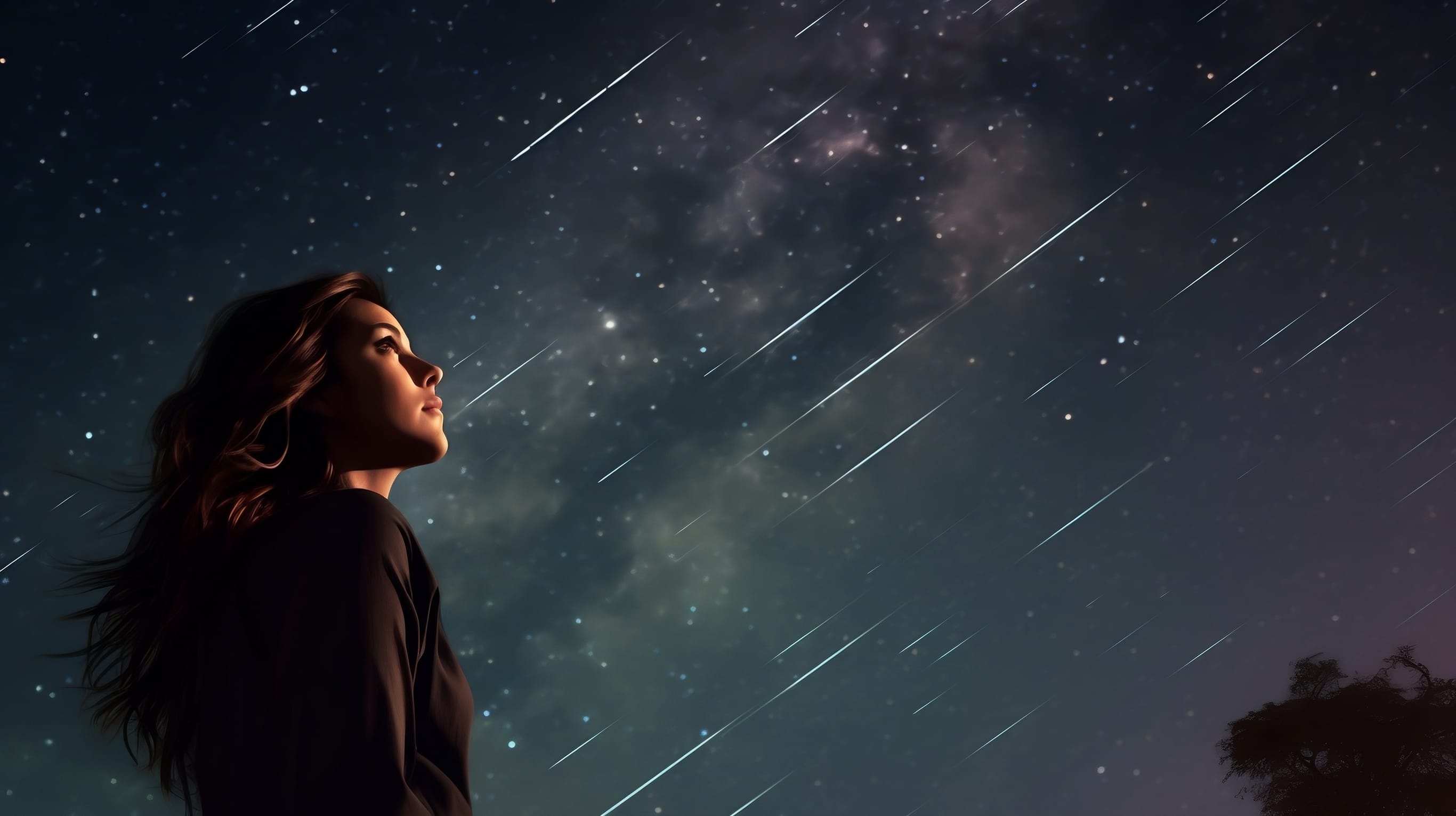2025年ペルセウス座流星群の見頃いつ?見やすい時間帯と場所
ペルセウス座流星群は7月17日から8月24日まで活動しており、8月12日に極大を迎えます。その夜は月明かりが明るくなりますが、楽しみを台無しにさせないためのちょっとした工夫があります。ご自身の場所で観察を始める最適なタイミングを確認するには、Sky Tonightを使ってください。そして、流星ショーのウォームアップとして、8月10日の明け方の空に現れる珍しい6つ惑星の直列もお見逃しなく!また、2025年のペルセウス座流星群の観察方法を解説したこのガイドもご覧ください。
内容
ペルセウス座流星群が見える場所

北半球に、ペルセウス座流星群は空のどこからでも見えますが、その軌道はペルセウス座にさかのぼります。これは流星群がペルセウス座から来るように見えるため、ペルセウス座流星群と呼ばれるのです。星座の中には、流星が出てくるように見える特定の点があり、これを放射点と呼びます。放射点が高く上がるほど、見える流星の数が増えます。最も多くの「流れ星」を捉えるためには、放射点が空高く上がる時間帯に観測を集中させることが重要です。
頭上の放射点がどれくらい高く昇っているかを知るには、Sky Tonightアプリを使ってください。検索バーに「ペルセウス座流星群」と入力し、青いターゲットアイコンをタップすると、放射点の現在の位置が表示されます。画面上部のタイムマシン機能を使えば、あなたの場所で放射点が最も高くなる時間も分かります。詳しくはSky Tonightのビデオガイドをご覧ください。
また、Star Walk 2でもペルセウス座流星群の放射点を見つけられます。このアプリは初心者に優しく、素晴らしい3Dグラフィックを備えています。使い方はStar Walk 2チュートリアルで学べます。
2025年ペルセウス座流星群の見える場所

ペルセウス座流星群は中北緯度で最もよく観測されます。ペルセウス座流星群の放射は、現地時間22:30頃に空高く昇ります。残念ながら、ペルセウス座流星群は南半球のほとんどの地域からは正しく見ることができません。
ペルセウス座流星群はいつ?
ペルセウス座流星群は毎年7月中旬から8月下旬にかけて出現します。2025年のペルセウス座流星群の活動期間は7月17日から8月24日です。この期間中は時折いくつかの流星が見えることもありますが、流星群が極大を迎えて流星の数が最も多くなる8月12日頃が観察に最も適した時期です。
2025年ペルセウス座流星群の見頃
ペルセウス座流星群は、ピーク時には1時間に約100個の流星を発生させ、最も流星が多い流星の1つと考えられています。国際流星機構によると、2025年のペルセウス座流星群のピークは8月12日13:15 GMTに予測されています(また、8月12日04:00 GMT以降には、地球が古いダストトレイルに遭遇し、流星の数が増える可能性があります)。
残念ながら、このイベントは満月の3日後に発生するため、空は90%照らされた月によって一晩中明るくなり、暗い流星が見えにくくなるでしょう。この影響を軽減するためには、高い建物や木、山の影に隠れて月明かりを遮るようにしてください。また、観測は夜明け前の時間帯に計画すると、空が暗くなるかもしれません。ピーク後でも流星群はまだ活動しているので、ピークの夜の後に観測を試みると、月明かりの影響が少なくなるでしょう。
ペルセウス座流星群を追うアプリ
天文アプリを使えば、ペルセウス座流星群を観察するベストなタイミングを見逃しません。Sky Tonightには各流星群の活動期間と極大を示す専用カレンダーが入っています。このビデオチュートリアル で Sky Tonight のカレンダーの使い方を学びましょう。
Star Walk 2アプリも、今後の流星群の一覧を表示し、流星群が極大に近づくと通知してくれます。流星観察の夜の計画方法を解説したチュートリアルビデオもぜひご覧ください。
ペルセウス座流星群の見方
最適なビューを捉えるために役立ついくつかのアドバイスを集めました。適切な準備をすれば、2025年のペルセウス座流星群は思い出に残る星空体験をお届けします。そして、流星群に関するインフォグラフィックをクイックリファレンスとしてご利用ください。そこでは、カラフルなイラストの形でこれらのヒントを見つけることができます。

何をすべきか:
- 月から隠れる:高い障害物(山、建物、木など)のある場所を見つけて月明かりを遮りましょう。これにより夜空が暗くなり、より多くの流星を観測しやすくなります。
- 放射点が空で最も高く昇ったときに観察を始めましょう。そのときが一番多く流星が見える可能性が高いです。Sky Tonightアプリを使えば放射点の位置を特定し、観察に最適な時間を知ることができます。
- 都会の光から離れた暗い空の場所を見つけてください。都市部では見える流星の数が約10分の1に減ってしまいます。さらに良いのは山に登り、もやや雲が自分より下にあるような場所です。
- できるだけ多くの流星を見るために、この息づまるイベントを少なくとも1時間をかけて方がいいです。
- デッキチェアやキャンプベッドを横にして方がいいです。マットを使用することもできますが、血が流れないように頭を上げる必要があります。そうしないと、すぐに眠気を感じるようになります。
何をすべきでないか:
- ほとんど短い流星があるので、放射点を直接見ない方がいいです。
- 地平線の上を見下ろしないで方がいいです。霞や雲があるかもしれないのです。
- 火をつけたり、明るい懐中電灯をつけたりしないで方がいいです。明るい光は目を暗闇に順応させることを許さないので、流星の重要な部分を見ることができません。代わりに赤色灯の懐中電灯を持参したほうがよいでしょう。このライトは、夜間はより快適です。また、星空観察アプリのナイトモードをオンにするのを忘れないでください。赤いトーンを使っていて、暗所視力を保護します。
- 1時間まっすぐ見つめるのではなく、5〜10分の休憩をとります。これにより、集中力を維持し、目を休めることができます。
もっと役立つ流星観察のコツが知りたいですか?クイズに参加して、プロのように流れ星を見つける方法を楽しみながら学びましょう!

ペルセウス座流星群の原因

流星群は、彗星や(まれに)小惑星が残した破片の痕跡を地球が通過するときに発生します。それぞれの流星群には母天体があり、ペルセウス座流星群の母天体は大きな周期彗星であるスイフト・タットル彗星です。この彗星は133年に1度しか地球に接近しないが、地球は毎年彗星の痕跡を横切るため、ペルセウス座流星群は毎年観測されます。
彗星スイフト・タットルは地球に衝突する?
彗星109P/スイフト・タットルが最後に地球に接近したのは1992年で、次回は2126年に予測されています。ある天文学者がその軌道を計算した際、2126年に地球と衝突する可能性があると提案しました。しかし、その後の精密な計算により、彗星が地球に衝突する危険はないことが確認されました。
ペルセウス座流星群の流星は地球に衝突する?
ペルセウス座流星群の流星は基本的に彗星の破片、すなわち微小な塵や氷の粒です。これらは非常に脆く、大気に突入すると分解します。ほとんど地上に到達することはありませんが、もし到達した場合、それは「隕石」と呼ばれます。隕石と流星体の違いを知りたいですか?スペースロック・クイズを受けて確かめてください!

ペルセウス座流星群の伝説
ペルセウス座流星群のピークは、258年8月10日に処刑されたキリスト教の殉教者、聖ローレンスの祝日とほぼ同時期にあたります。ローレンスは鉄板の上で生きたまま焼かれたとされ、芸術作品ではしばしば鉄板を持つ姿や炎に包まれる姿で描かれます。処刑中、彼は驚くべき勇気と落ち着きを示し、処刑人に「片側が焼けたので、ひっくり返してくれ」と言ったと言われています。この伝説から、一部のカトリックの伝統では、ペルセウス座流星群の流星は「聖ローレンスの涙」として知られています。
2025年のペルセウス座流星群:知っておくべきこと
2025年のペルセウス座流星群についての最重要ポイントを簡単にまとめました:
- 活動期間:7月17日〜8月24日
- ピーク:8月12日13:15 GMT
- 観測に最適な時間:8月11日〜12日の夜(GMTより西のタイムゾーンの場合)および8月12日〜13日の夜(GMTより東のタイムゾーンの場合)、夜明け前の時間帯
- 最適な観測場所:北半球の中緯度地域
- ピーク時の予想流星数:100個/時間(実際には月明かりの影響でかなり少なく見えるでしょう)
- 月の位相:更待月(照度90%)
インタラクティブな星図と使いやすい天文カレンダーが一体になったSky Tonightをダウンロードしてください。さらに星空コンテンツを楽しみたいなら、SNSもチェックを。快晴を祈りつつ、流星観察をお楽しみください!
